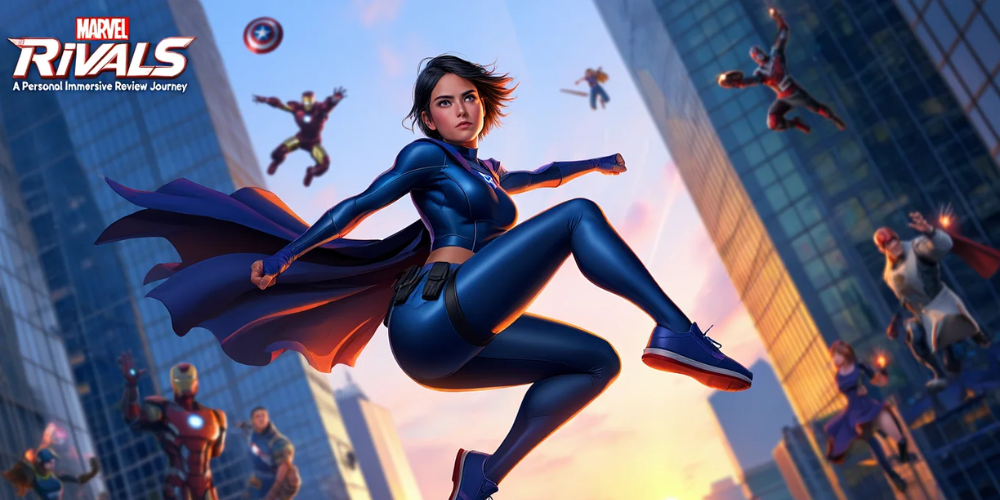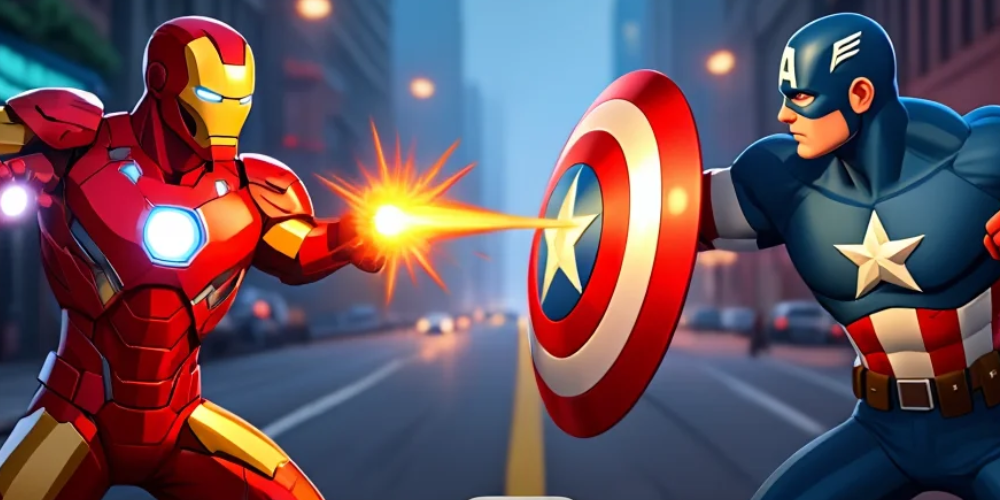Marvel Rivals: A Personal Immersive Review Journey
Jun 06, 2025

From the very beginning, Marvel Rivals captivated me with its blend of vibrant aesthetics and engaging gameplay mechanics. I was instantly drawn to the unmistakable flair of the superhero genre, where every detail—be it the crisp animation or the nuanced character designs—recalled the richness of the comic universe that I have admired for years. As soon as I booted up the game, I felt like I was stepping into a digital comic book, with every frame brimming with energy and personality. The introductory sequence alone, filled with dynamic visuals and a dramatic score, set the tone for what promised to be an unforgettable adventure into the world of Marvel’s iconic heroes.
Unraveling the Gameplay: A Blend of Strategy and Action
Playing Marvel Rivals has been an experience that seamlessly blends strategic planning with fast-paced action. I found myself constantly making split-second decisions during intense encounters. The combat mechanics are intuitive yet deep, requiring both tactical thinking and reflexes. Throughout the game, I was challenged by the intricate balance between offensive maneuvers and defensive strategies. Each encounter forced me to adapt my approach based on the unique powers of different characters. The controls felt responsive, and the smooth animations during combat made every explosion of superhero energy feel satisfying and impactful.
What really kept me hooked was how the gameplay evolves as I progressed through the game. Early challenges introduced me to a core set of moves and basic mechanics, but as I advanced, new layers of gameplay were unlocked. This gradual increase in complexity ensured that I was never overwhelmed by too many mechanics at once, allowing me to master each new element before moving on to more challenging scenarios. I appreciated the game’s patience with newcomers while still offering enough depth for seasoned players to test their mettle.
Immersive Visuals and Artistic Flair
The visual style of Marvel Rivals is nothing short of spectacular. As a longtime fan of the Marvel universe, I was thrilled by how closely the game’s art direction mirrors the classic comic-book feel. Each character is rendered with striking attention to detail, from the textured costumes to the expressive facial animations that capture a range of heroic emotions. The vibrant color palette evokes the energy of comic panels, and I often found myself stopping mid-game to admire the artistry in special cutscenes or visually intense battle sequences.
The environmental design is equally noteworthy. Whether I was exploring urban landscapes or entering secret hideouts, every location felt alive with small details that hinted at stories beyond the immediate gameplay. The lighting effects during high-tension moments added an extra layer of drama, and the motion blur during rapid movements conveyed a sense of speed and impact that made every confrontation feel cinematic. I particularly enjoyed the way dynamic weather effects sometimes played a subtle role in gameplay, altering visibility and even impacting character performance during certain missions.

Diving into the Story: Heroes, Rivals, and Narrative Twists
One of the most rewarding aspects of Marvel Rivals for me was its engaging narrative. The game’s storyline isn’t just a backdrop to the action; it’s a well-integrated element that draws you deeper into the world. As I navigated through the rich narrative, I encountered familiar heroes in unexpected circumstances, and some who had surprising rivalries that added layers of complexity to their personalities. Every mission I undertook felt woven into a broader tapestry of conflicts, alliances, and personal journeys that have defined the Marvel legacy over the decades.
The game’s narrative cleverly balances humor, suspense, and emotional weight. I was particularly impressed by its dialogue, which managed to capture the witty banter characteristic of Marvel interactions without overshadowing the seriousness of the stakes involved. The interludes between action sequences often gave me a moment to breathe and connect with the characters, making them feel vibrant and real. I found myself rooting for them, questioning their motives, and eagerly anticipating each plot twist as the stakes grew ever higher in my personal journey through the game.
Character Progression and Personal Empowerment
My journey through Marvel Rivals was not just about external battles; it was also a personal evolution as I grew closer to the heroes I commanded. The character progression system in the game is robust and thoughtfully designed. Every victory and defeat contributed to the development of my character’s abilities. I relished in the freedom to customize powers and skills, creating a playstyle that was uniquely mine. Choosing which upgrades to pursue became an absorbing strategic element that made each playthrough different.
Every time I unlocked a new ability or saw my stats improve, I felt a surge of personal empowerment—a sense that I was truly becoming one with the hero I admired. The progression system didn’t just involve numbers; it also integrated narrative rewards that enriched my experience. Special storyline relics or interactions unlocked by reaching certain milestones served as a reminder that my journey was interwoven with the fabric of the Marvel universe. It wasn’t just about winning battles; it was about evolving and connecting with the journey of the characters I had long admired.
The Nuances of Combat Mechanics and Strategy
Beyond the surface-level excitement of superhero battles, Marvel Rivals offered me a treasure trove of tactical combat scenarios that demanded thoughtful strategy. I found that each character brought something different to the table—a unique set of skills and attributes that required me to plan my moves carefully rather than just relying on rapid reflexes. In some encounters, brute force was not the answer; I had to perform well-timed defensive moves and counterattacks to exploit enemy weaknesses. This layer of strategic planning kept the battles unpredictable and exhilarating.
During particularly challenging segments, I was forced to experiment with combinations of abilities. The satisfaction of executing a perfect combo that left my foes reeling remains one of my favorite memories from the game. It was not uncommon to find my heart racing as I prepared for an encounter, knowing that the intricate interplay of abilities would demand everything I had learned. The learning curve was steep at times, but it was always balanced by rewarding moments that reinforced my progress. I also appreciated how the game occasionally gave me subtle hints during combat, nudging me in the right direction when new mechanics were introduced without ever spoon-feeding me the gameplay.
The Soundscape: A Symphony of Heroic Tones
Audio plays an essential role in shaping my gaming experiences, and Marvel Rivals delivered on this front magnificently. The soundtrack is both emotionally stirring and dynamically adaptive to the on-screen action. I found that the music would swell during key moments, heightening the drama of large-scale confrontations, and then ease into softer, introspective tones during story sequences. The audio design goes beyond just background music; it incorporates environmental sounds, character voices, and subtle audio cues that enhance the overall immersion.
I was particularly moved by the carefully chosen voice acting of the characters, which breathed life into their personalities. Every line of dialogue carried weight because the tone and delivery resonated perfectly with the character’s persona. In quieter moments, the ambient sounds—ranging from the hum of cityscapes to the distant echoes in abandoned bases—added a layer of realism that deepened my connection to the game’s world. I always found it astonishing how a nuanced soundscape could transform a virtual environment into something that felt palpably alive.
Immersive Exploration and Environmental Interaction
Marvel Rivals isn’t merely a series of linear battles; it is an expansive universe that invites exploration. I was delighted by the freedom the game provided to roam throughout richly detailed environments. Each area was meticulously designed to evoke a sense of place, inspiring me to pause and absorb every bit of the surroundings. The urban districts, industrial zones, and hidden fortresses are interwoven with secrets that rewarded exploration while expanding the overarching narrative.
While roaming through the environments, I discovered hidden lore elements that provided context to the conflict between the heroes and their adversaries. Subtle environmental storytelling—graffiti on walls, scattered documents, and remnants of past clashes—offered insights into the world’s history. I felt as though every nook and cranny was an invitation to uncover a deeper layer of narrative that connected personal hero stories with larger events. The interactive elements allowed me to engage with objects in the environment, sparking minor side quests and earning bonus rewards that enriched my investigation of the Marvel universe.
Thrilling Multiplayer Interludes and Cooperative Ventures
One of the aspects that added significant replay value to Marvel Rivals was its focus on multiplayer engagement. While I initially immersed myself in the game’s single-player campaign, I soon sought the camaraderie and challenge of multiplayer modes. Competitive encounters where I battled other players felt like an extension of the comic book rivalries that the game so beautifully encapsulates. Sharing tactics, strategizing with friends, and even competing against some of the best players online added a dynamic layer to the overall experience.
In cooperative missions, I found that teamwork was more than just a neat concept—it was a necessity. My allies and I coordinated our efforts, balancing our characters’ unique abilities in real-time scenarios that demanded precision and trust. I often relished those moments of synchrony, where a perfectly executed team strategy raised the intensity of every encounter. The communal spirit altogether made me feel like part of an extended family of passionate gamers who shared a deep love for the Marvel saga. These online interludes were an invigorating break from the narrative, emphasizing the game’s commitment to fostering community connection.

Robust Customization: Tailoring the Experience
The level of customization available in Marvel Rivals was a pleasant revelation that appealed directly to my personal taste. I appreciated the flexibility offered by the character customization system, where I could fine-tune various aspects of my hero’s appearance and abilities. Whether it was adjusting the color palette of my costume or reallocating skill points to emphasize a particular style of play, every modification felt meaningful. The game gave me the chance to imprint a piece of my personality onto the character, transforming the experience into something uniquely mine.
This customization extended beyond just superficial choices—it influenced how I navigated the challenges within the game. I could experiment with diverse builds that catered to different strategies, making each playthrough a fresh experience. The interface for customization was user-friendly, complete with detailed descriptions of each upgrade, which ensured that I felt informed and empowered while making decisions about my hero’s path. I found that the sheer variety of customization options offered a layer of replayability that encouraged me to try out multiple configurations, each providing a different flavor of the superhero experience.
Examining the Challenge and Learning Curve
Marvel Rivals managed to strike a refined balance between accessibility and challenge, a balance that resonated deeply with my personal play style. The game does an excellent job of easing players into its more complex mechanics without ever becoming patronizing. I appreciated the way tutorials were woven seamlessly into the early missions, allowing me to master the controls and combat tactics without feeling overwhelmed. As I progressed, the complexity of challenges naturally increased, yet I never felt that the game was punishing me unfairly for experimentation.
The game introduces higher stakes at just the right moments, encouraging heightened focus and strategic thinking. For example, certain missions required careful coordination of multiple abilities simultaneously, which pushed me to hone my skills. I encountered puzzles and environmental obstacles that demanded a combination of sharp reflexes and thoughtful analysis. Overall, the learning curve was gratifying because every difficulty I faced ultimately made my victories more rewarding. I found that overcoming these challenges significantly enhanced my awareness of the game’s mechanics, deepening my overall engagement and understanding of the Marvel universe.
Social Impact and the Connection with the Global Community
Beyond the solo adventure and multiplayer challenges, Marvel Rivals has been a platform for a broader cultural conversation. Engaging with online forums and communities dedicated to the game enriched my experience, offering insights and strategies that enriched my understanding. I was fascinated by the way other fans analyzed the narrative, dissected character arcs, and shared content that celebrated the game’s achievements in design and storytelling.
This exchange of ideas and enthusiasm helped me appreciate the game from multiple perspectives. I often engaged in conversations where fellow players compared notes on subtle narrative hints or debated over the best character builds. These interactions reinforced the notion that Marvel Rivals is not merely a digital experience but a cultural phenomenon that connects players around the world. Participating in community challenges and events allowed me to see how diverse strategies and experiences compound to create a living, breathing ecosystem of Marvel enthusiasts. This communal aspect not only sparked friendly competition but also nurtured a sense of belonging in the superhero fandom.
Balancing Strategy and Spontaneous Action
One of the most compelling dimensions of Marvel Rivals is its careful balance between methodical strategy and spontaneous action. Throughout my journey, I witnessed firsthand how the game harnesses the unpredictability of combat, ensuring that no two encounters were ever the same. This unpredictability kept me alert at all times, often forcing me to abandon a pre-planned strategy in favor of quick adaptability. The game mechanics respect the organic flow of battle, meaning that even the most meticulously crafted plan needed room for flexibility under pressure.
The thrill of those unplanned moments—the split-second decision to switch tactics and the rush of successfully adapting to a sudden shift—remains etched in my mind. I found that each tactical choice, whether carefully thought out or made in the heat of battle, contributed to an overall dynamic experience that constantly pushed me to excel. The juxtaposition of strategic planning with immediate physical engagement speaks to the game’s sophisticated design philosophy, which celebrates both method and spontaneity in equal measure. For me, this balance translated into an experience that was as intellectually stimulating as it was physically demanding, making every moment in Marvel Rivals a fresh challenge.
Integration of Narrative and Gameplay: A Symphony in Motion
The interplay between narrative and gameplay in Marvel Rivals is one of the pillars that make the game truly stand out. As I progressed through the chapters of the game, I found that the story and the action choreographed themselves into a single, coherent experience. Every heroic moment, every bout of intense combat, was underscored by narrative cues that imbued the action with meaning and context. I was never merely participating in a series of matches; I was engaged in a sprawling saga where my actions had concerted consequences on the evolving storyline.
This synthesis was particularly evident during high-stakes missions where narrative elements broke through the gameplay, providing clarity on the stakes at hand. The dialogue during these moments was laced with emotion and urgency, making me feel that every decision I made not only impacted my hero’s trajectory but also the broader war between rival factions. I found immense satisfaction in witnessing how my in-game growth was mirrored by shifts in narrative tone and character interactions. This tight integration of narrative and gameplay kept me thoroughly invested, as the game constantly challenged me to balance combat performance with narrative progression.
Examining the Subtleties of AI Behavior and In-Game Dynamics
The behavior of enemy and allied units in Marvel Rivals was another facet that struck me as particularly refined. I noticed that the in-game artificial intelligence was consciously designed to present a realistic sense of rivalry and camaraderie. Enemies were not mere obstacles; they exhibited varying patterns of behavior that made each confrontation feel distinct. Some adversaries relied on brute force, while others employed deceptive maneuvers that required careful observation and timely response. This nuanced approach to AI behavior not only deepened the immersive quality of the game but also compelled me to continuously adapt my strategies during combat.
Likewise, the behavior of allied characters during cooperative multiplayer segments was programmed to be both supportive and independent. Their actions often reminded me of a well-rehearsed team, each member contributing to the overall success in a manner that felt genuine. Observing my AI allies work in tandem with my efforts gave me confidence, yet also reminded me that the game thrives on the unpredictability of human-like decision-making. This blend of programmed intelligence and emergent gameplay dynamics made every fight a unique tactical scenario, keeping me constantly on my toes as I anticipated new types of challenges.
Innovative Challenges and Rewarding Side Quests
Marvel Rivals goes beyond the expected narrative to present a wealth of side quests and hidden challenges that enriched my journey. I relished the opportunity to explore paths that weren’t strictly required by the main storyline, as these diversions often revealed fascinating lore and special in-game rewards. The side quests varied in complexity, ranging from simple fetch tasks to elaborate puzzles that demanded clever solutions and deep exploration of the game’s universe. Each of these diversions extended my playtime and provided delightful surprises that often complimented the central narrative.
One memorable aspect of these side quests was how they honored the identities of the individual heroes. I encountered missions that played to the strengths of specific characters, allowing me to delve into their backstories and understand their motivations on a deeper level. The variety in challenges meant that there was always something new awaiting me at every corner of the map, and I often found that some of the best experiences cropped up during these unplanned adventures. Whether deciphering cryptic riddles in secluded hideouts or engaging in unexpected skirmishes with notorious rival groups, each side quest left me feeling more connected to the overall narrative and more invested in the game world.
Customization of Strategy and Adaptability in Every Encounter
As I continued my journey through Marvel Rivals, I was repeatedly impressed by the depth of strategic customization available. Every match, every mission, came with its own unique set of challenges that required me to adapt and adjust my approach continuously. I found that the game encourages innovation in tactics—what worked brilliantly in one scenario often needed tweaking in the next. This constant need for adaptation kept me engaged and willing to experiment with different strategies, ranging from aggressive fast-paced methods to more calculated, defensive plays.
One aspect that stands out is the game’s emphasis on rewarding adaptive thinking. When I successfully modified my strategy on the fly, I felt a surge of accomplishment that was both satisfying and motivating. Over time, I was able to develop a sense of intuitive mastery, learning to anticipate enemy moves and choosing the optimal moments to execute my abilities. The game’s design ensured that there was rarely a one-size-fits-all solution, and every encounter nudged me toward creative problem-solving. Within this dynamic environment, each battle transformed into a unique puzzle, where my evolving strategies served as the keys to unlocking progressively intricate challenges.
Evolving Dynamics and the Living Marvel Universe
Marvel Rivals has done an exceptional job of making its world feel real and ever-changing. The in-game dynamics evolve in meaningful ways, providing me with a sense that the universe is alive outside of the immediate gameplay. I observed changes in the environment that reflected the outcomes of major missions, with cityscapes showing signs of tension or recovery as the narrative progressed. Even subtle shifts, like changing weather patterns or evolving backdrops during cutscenes, contributed significantly to the perception of a living world influenced by the ongoing conflict between heroes and antagonists.
This evolving universe provided an innovative twist to the traditional static game settings. For me, every visit to a familiar location felt like an opportunity to witness a new chapter unfolding. The developers have clearly invested effort into ensuring that every narrative decision has a visible impact on the world. This level of detail and responsiveness made my experience uniquely dynamic. It wasn’t merely about progressing through a fixed storyline; it was about becoming part of an ever-adapting spectacle full of unexpected environmental cues, evolving challenges, and recurring themes that resonated with my love for the Marvel tradition.
Exploring the Depth of the Sound Design in Dynamic Environments
Throughout my journey with Marvel Rivals, I have repeatedly been impressed by how sound design accentuates every facet of the experience. Beyond the immediate impact of a powerful soundtrack, ambient noises and subtle audio transitions contributed profoundly to the overall atmosphere. I found that the soundscape in each area was crafted to enhance the emotional tone of the gameplay—a quiet yet tension-filled hum during stealth-like missions, a burst of triumphant orchestration when I achieved significant milestones, and carefully layered background noises that enriched urban and exotic locations alike.
What struck me most was the degree of synchronization between the audio and the on-screen events. In moments of dire conflict or unexpected plot twists, the sound design seemed to anticipate and amplify the emotional stakes. This intentional audio storytelling deepened my immersion, making the virtual environments feel tangibly real. Every footstep, every explosion of a well-executed move, reverberated in harmony with the intricate score, and I found that paying attention to these detailed cues often provided me with subtle hints on what to expect next in both narrative and combat. The acoustic mastery of Marvel Rivals truly elevated my engagement, transforming each session into a multisensory experience that lingered with me long after I paused the game.








